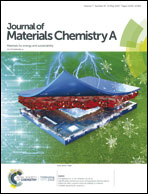Novel two-dimensional molybdenum carbides as high capacity anodes for lithium/sodium-ion batteries†
Abstract
Searching for high performance electrode materials is one of the key factors for next generation renewable energy technologies. Here, based on the structure of two dimensional (2D) transition metal carbides (MXenes) Mo2C, we report novel 2D MoxCy (x, y = 1 or 2) phases with great potential as anode materials for both lithium-ion batteries (LIBs) and sodium-ion batteries (SIBs) through a first principles swarm structural search. The predicted 2D MoC and MoC2 monolayers exhibit great stabilities, metallic conductivities, and excellent electrode performances. Interestingly, the structure of the MoC2 monolayer is composed of C2 dimers without metal atoms directly exposed on the surface, suggesting that the surface functionalization occurring in MXenes can be effectively avoided, which is beneficial for maintaining good stability of the anode materials. Furthermore, the MoC2 monolayer exhibits superior LIB and SIB performances with high theoretical storage capacities (893.5 and 446.9 mA h g−1) and small diffusion energy barriers (0.15 and 0.23 eV) for Li and Na atoms, respectively. These intriguing results demonstrate the robust applicability of the predicted monolayers as ideal anode materials for both LIBs and SIBs.



 Please wait while we load your content...
Please wait while we load your content...